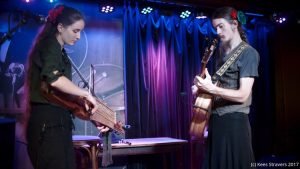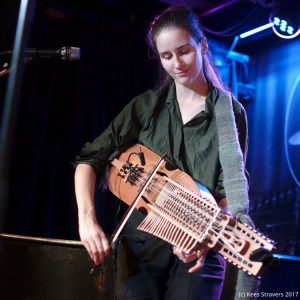
Two talented young musicians, one playing nyckelharpa, the other guitar. Sometimes it doesn’t take more than that to make a beautiful album. The Swiss duo Emilie Waldken and Pascal Rüegger, together known as KNEP, did just that and we at CeltCast are more than happy to introduce their music!
Emilie Waldken studied classical violin, after which she was introduced to the nyckelharpa and Scandinavian music and it was love at first sight. In her own words; ‘the discovery of the nyckelharpa was key in my life.’ She eventually went to Sweden to study Swedish folk music on the Eric Sahlström institutet.
Besides KNEP she plays in the medieval/fantasy band Skoga Obscura which she founded. She also does a lot of solo performances and teaches.
Pascal Rüegger studied music on the Zürcher hochschule der kunste in Zurich. He also went to Sweden to study Scandinavian folk, although his focus was more on dance. He now gives workshops in traditional Nordic- and Balfolk dances. He is also busy with quite a few jazz- and theatre projects.
Together Emilie and Pascal form the duo KNEP. Their first album Bestioles came out on the 13th of February 2016. When asked how KNEP was formed Emilie said: “It was a bit before heading to Sweden that Pascal and I met during a Balfolk ball. First we jammed, slowly a common repertoire was created and one day we stepped on stage and KNEP was born. So our duo is really a classical violinist having a passion for Scandinavian folk fiddling and nyckelharpa who met a jazz guitar and bass player and them ending up together! We like to stick to the Scandinavian style, using the tradition we both studied as much as possible.”
(The complete interview we did with KNEP can be found here)
 With both Emily Waldken and Pascal Rüegger loving Swedish folk-, Balfolk-, classical- and jazz music, it’s no surprise that KNEP’s sound is indeed a blend between Swedish Traditional music, Balfolk and classical chamber music with a splash of jazz.
With both Emily Waldken and Pascal Rüegger loving Swedish folk-, Balfolk-, classical- and jazz music, it’s no surprise that KNEP’s sound is indeed a blend between Swedish Traditional music, Balfolk and classical chamber music with a splash of jazz.
On Bestioles you’ll find 11 lovely folk songs. Introducing us to different types of Scandiavian traditional music and some balfolk too. Five of the songs are Polska’s, one is a Circassien Circle. There is a Waltz, a Scottish and two Mazurka’s. Five songs are traditionals, Pascal wrote four and Emilie has five to her name. For the fast mathematicians, yes that adds up to more then eleven, but some songs are actually two tunes blended together. Something you will surely notice reading the song-titles. All arrangements are by Emilie and Pascal. The latter is also responsible for recording Bestioles.
The first song MCP + La verte shows all the duo’s strong points. It starts with a jazzy rhythm played by Pascal on guitar and he is soon accompanied by Emilie’s nyckelharpa. Although the first time I heared the music I mistakenly thought it was played with a octavharpa. Not true Emilie told me. Her nyckelharpa has a 4-row keyboard, which explains the deep almost cello like sound on this (and other) songs. As the nyckelharpa’s melody on MCP + La verte is in the range of a cello, you would expect these two combined compositions by Pascal to be melancholic, but they are not. It’s actually a cheerfully played Polska, especially the second part La verte.
The second song Chévrefeuille (French for Honeysuckle) is a composition by Emilie. This song is still evolving when they play it live with Emilie adding new parts to it on a regular basis. Again, a nice cheerful song, with Pascal on low whistle. The composition has a lot of variations on the main theme and changes in tempo, keeping it interesting until the last note.
Polska från Dorothea starts with a lovely nyckelharpa intro from Emilie, with Pascal´s guitar joining in. Both instruments blend into a beautiful, gentle piece of music. By now it’s clear that both Emilie and Pascal are excellent musicians. Although all songs are instrumental, you don´t miss vocals. As is to be expected from well composed classical music, the instruments themselves are the voices. In the artwork Knep tells that this Polska has been among their favourites for a long time. It could well be my favourite too.
Celle-ci is a Mazurka. It´s also a solo piece for guitar and it´s beautiful, starting real small, delicate and tender. The song shows how beautiful classical acoustic guitar can be, when played by a skilled musician. Another personal favourite of mine.
The uptempo Le Troll du Chateau de Joux + The Gallowglass brings us to another Balfolk dance classic. The Circassien Circle dance. At this point I noticed another strong point of the CD. Its variation. I am taken from dance tunes to delicate solos. One moment the guitar will lead the way, the next song the nyckelharpa takes center stage. From open chords to rhythm, from Polska’s to a Waltz, the songs are never the same. I really have to compliment KNEP on the song choice and the placement of them on the album. It is so well balanced, so well thought out that it keeps being interesting.
Not all songs are Swedish folk inspired. Suka-fiol is a Waltz Emilie wrote when she heard about the Suka, a special fiddle from Poland. Maybe it sounds Polish, maybe not, but it’s definitely a nice Balfolk song.
 Eikelandsosen
is a solo piece for nyckelharpa. And here I have to compliment Pascal on his recording skills. The whole album is recorded with minimal usage of effects, giving it a direct, pure and honest sound. In this song it works so well. You can really hear all the ‘clicks’ of the nickelharpa keys being touched. If you close your eyes you can just imagine Emilie sitting next to you, playing you this wonderful instrument.
Eikelandsosen
is a solo piece for nyckelharpa. And here I have to compliment Pascal on his recording skills. The whole album is recorded with minimal usage of effects, giving it a direct, pure and honest sound. In this song it works so well. You can really hear all the ‘clicks’ of the nickelharpa keys being touched. If you close your eyes you can just imagine Emilie sitting next to you, playing you this wonderful instrument.
The last song I want to mention is L’autre Route, a delicate duet between guitar and nyckelharpa. A worthy end to this beautiful album. Bestioles nicely fills in the gap between Balfolk, as played by the likes of Finvarra, and Baroque style chamber music. It’s not an album that will make you jump and run through your house dancing. It’s an album you want to play to calm down and forget the stress of the day. It leaves you feeling positive and relaxed. A great value nowadays.
– Cliff
– Concert photo’s courtesy of Kees Stravers.
– Band portrait courtesy of Knep.